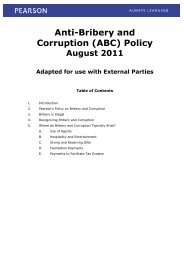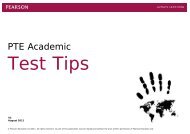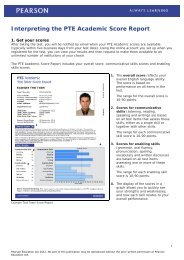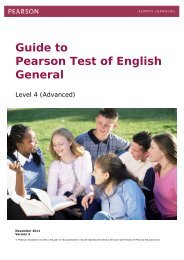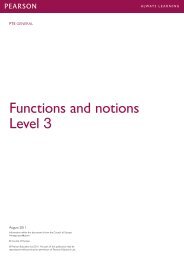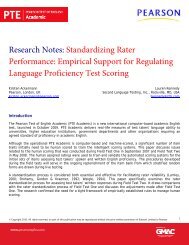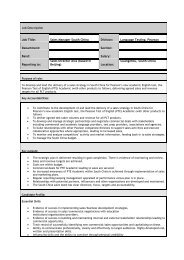Versant English Test: Test Description and Validation Summary
Versant English Test: Test Description and Validation Summary
Versant English Test: Test Description and Validation Summary
Create successful ePaper yourself
Turn your PDF publications into a flip-book with our unique Google optimized e-Paper software.
Of the 63 items in an administration of the <strong>Versant</strong> <strong>English</strong> <strong>Test</strong>, 54 responses are currently used in<br />
the automatic scoring. The first item response in each part of the test is considered a practice item<br />
<strong>and</strong> is not incorporated into the final score. The three Story Retelling items will be incorporated into<br />
the scoring soon. The two Open Questions are not scored automatically. Figure 3 illustrates which<br />
sections of the test contribute to each of the four subscores. Each vertical rectangle represents a<br />
response from a test taker. The items that are not included in the automatic scoring are shown in<br />
grey.<br />
Pronunciation Fluency Sentence Mastery Vocabulary<br />
Reading Sentence Repeating Short Answer Questions<br />
Sent. Build SR OQ<br />
Figure 3. Relation of subscores to item types.<br />
Among the four subscores, two basic types of scores are distinguished: scores relating to the<br />
content of what a test taker says (Sentence Mastery <strong>and</strong> Vocabulary) <strong>and</strong> scores relating to the<br />
manner (quality) of the response production (Fluency <strong>and</strong> Pronunciation). This distinction<br />
corresponds roughly to Carroll’s (1961) distinction between language performance in relation to a<br />
knowledge aspect <strong>and</strong> a control aspect. In later publications, Carroll (1986) identified the control<br />
aspect as automatization, which suggests that people speaking fluently without realizing they are<br />
using their knowledge about a language have attained the level of automatic processing as described<br />
by Schneider & Shiffrin (1977).<br />
In each section of the <strong>Versant</strong> <strong>English</strong> <strong>Test</strong>, each incoming response is recognized automatically<br />
by a speech recognizer that has been optimized for non-native speech. The words, the pauses, the<br />
syllables, the phones, <strong>and</strong> even some subphonemic events are located in the recorded signal. The<br />
content of the response is scored according to the presence or absence of expected correct words in<br />
correct sequences. The content accuracy dimension counts for 50% of the Overall score, <strong>and</strong> reflects<br />
whether or not the test taker understood the prompt <strong>and</strong> responded with appropriate content.<br />
The manner-of-speaking scores (Fluency <strong>and</strong> Pronunciation, or the control dimension) are<br />
calculated by measuring the latency of the response, the rate of speaking, the position <strong>and</strong> length of<br />
pauses, the stress <strong>and</strong> segmental forms of the words, <strong>and</strong> the pronunciation of the segments in the<br />
words within their lexical <strong>and</strong> phrasal context. These measures are scaled according to the native<br />
<strong>and</strong> non-native distributions <strong>and</strong> then re-scaled <strong>and</strong> combined so that they optimally predict the<br />
human judgments on manner-of-speaking (when the process is run on a reference set of non-native<br />
Pearson now includes Ordinate products <strong>and</strong> services. Page 12 of 28<br />
© 2008 Pearson Education, Inc. or its affiliate(s). All rights reserved. Ordinate <strong>and</strong> <strong>Versant</strong> are trademarks, in the U.S. <strong>and</strong>/or<br />
other countries, of Pearson Education, Inc. or its affiliate(s). Other names may be the trademarks of their respective owners.




